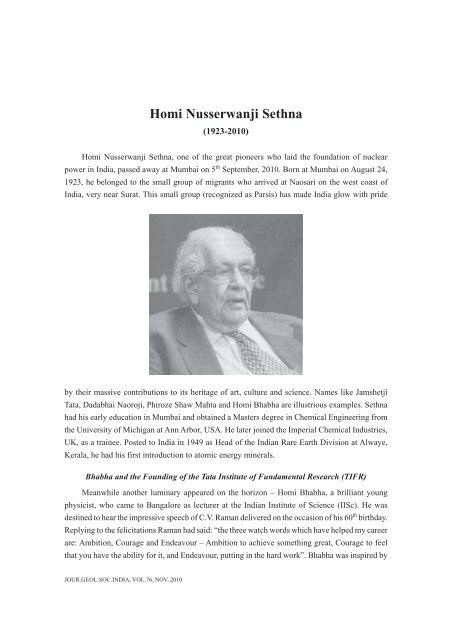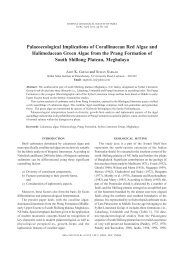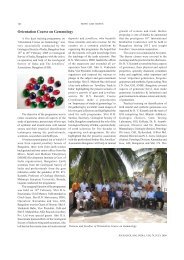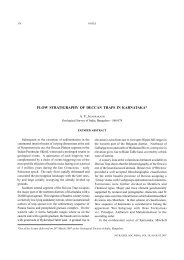Homi Nusserwanji Sethna - Geological Society of India
Homi Nusserwanji Sethna - Geological Society of India
Homi Nusserwanji Sethna - Geological Society of India
You also want an ePaper? Increase the reach of your titles
YUMPU automatically turns print PDFs into web optimized ePapers that Google loves.
HOMI NUSSERWANJI SETHNA 433<br />
<strong>Homi</strong> <strong>Nusserwanji</strong> <strong>Sethna</strong><br />
(1923-2010)<br />
<strong>Homi</strong> <strong>Nusserwanji</strong> <strong>Sethna</strong>, one <strong>of</strong> the great pioneers who laid the foundation <strong>of</strong> nuclear<br />
power in <strong>India</strong>, passed away at Mumbai on 5 th September, 2010. Born at Mumbai on August 24,<br />
1923, he belonged to the small group <strong>of</strong> migrants who arrived at Naosari on the west coast <strong>of</strong><br />
<strong>India</strong>, very near Surat. This small group (recognized as Parsis) has made <strong>India</strong> glow with pride<br />
by their massive contributions to its heritage <strong>of</strong> art, culture and science. Names like Jamshetji<br />
Tata, Dadabhai Naoroji, Phiroze Shaw Mahta and <strong>Homi</strong> Bhabha are illustrious examples. <strong>Sethna</strong><br />
had his early education in Mumbai and obtained a Masters degree in Chemical Engineering from<br />
the University <strong>of</strong> Michigan at Ann Arbor, USA. He later joined the Imperial Chemical Industries,<br />
UK, as a trainee. Posted to <strong>India</strong> in 1949 as Head <strong>of</strong> the <strong>India</strong>n Rare Earth Division at Alwaye,<br />
Kerala, he had his first introduction to atomic energy minerals.<br />
Bhabha and the Founding <strong>of</strong> the Tata Institute <strong>of</strong> Fundamental Research (TIFR)<br />
Meanwhile another luminary appeared on the horizon – <strong>Homi</strong> Bhabha, a brilliant young<br />
physicist, who came to Bangalore as lecturer at the <strong>India</strong>n Institute <strong>of</strong> Science (IISc). He was<br />
destined to hear the impressive speech <strong>of</strong> C.V. Raman delivered on the occasion <strong>of</strong> his 60 th birthday.<br />
Replying to the felicitations Raman had said: “the three watch words which have helped my career<br />
are: Ambition, Courage and Endeavour – Ambition to achieve something great, Courage to feel<br />
that you have the ability for it, and Endeavour, putting in the hard work”. Bhabha was inspired by<br />
JOUR.GEOL.SOC.INDIA, VOL.76,NOV.2010
434 B. P. RADHAKRISHNA<br />
these words to do something great himself and using his close friendship with Pandit Nehru, the<br />
Prime Minister <strong>of</strong> <strong>India</strong>, and the substantial funds <strong>of</strong> money which the Dorabji Trust promised, he<br />
started planning the establishment <strong>of</strong> a Research Institute <strong>of</strong> the country – the Tata Institute <strong>of</strong><br />
Fundamental Research (TIFR) at Mumbai. He was convinced that the prevailing system <strong>of</strong><br />
university education could not produce young men <strong>of</strong> the requisite talent and started searching for<br />
such young ones, H.N. <strong>Sethna</strong>, Raja Ramanna, M.G.K. Menon, M.R. Srinivasan and P.K. Iyengar<br />
were some <strong>of</strong> the young men picked out for his proposed institute.<br />
The new recruits became the forerunners <strong>of</strong> new technologies and heralded the beginning <strong>of</strong><br />
an extensive atomic energy programme. Cosmic ray research, the special field <strong>of</strong> Bhabha, continued<br />
with vigour and other new branches <strong>of</strong> study followed with the assistance <strong>of</strong> experts from abroad.<br />
The first computer was fabricated.<br />
There were changes in the programme <strong>of</strong> research at the new Institute. Instead <strong>of</strong> individuals<br />
working on separate items, team work formed the pattern. Groups <strong>of</strong> brilliant young men engaged<br />
themselves in these newer fields <strong>of</strong> research. Bhabha himself was interested in cosmic rays, while<br />
the study <strong>of</strong> nuclear energy was taken up by <strong>Sethna</strong> and Ramanna. Bhabha sent Ramanna to Kings<br />
College, London, where he secured a doctorate degree in nuclear physics. Atomic energy has<br />
made big strides as the bombs dropped on Hiroshima and Nagasaki demonstrated. The world was<br />
astounded at the extent <strong>of</strong> destruction produced. More particularly, the development <strong>of</strong> nuclear<br />
energy for the production <strong>of</strong> enormous amounts <strong>of</strong> power, so badly need had impressed the group<br />
working at TIFR. Government <strong>of</strong> the day led by Indira Gandhi lent support to the promotion <strong>of</strong><br />
nuclear project and the first bomb was planned and executed by the team headed by Ramanna and<br />
<strong>Sethna</strong>. The Atomic Minerals Division was set up with Dr. D.N. Wadia as the <strong>Geological</strong> Adviser,<br />
to locate deposits <strong>of</strong> uranium in the country.<br />
Director <strong>of</strong> BARC (1972-1983)<br />
<strong>Sethna</strong> who had joined the Atomic Energy establishment at Trombay as Chief Scientific<br />
<strong>of</strong>ficer was soon made the Director <strong>of</strong> the Engineering Group. He was responsible for the design<br />
and construction <strong>of</strong> the plutonium plant at Trombay. When Bhabha suddenly died in an air accident<br />
in 1966, <strong>Sethna</strong> was appointed as Director <strong>of</strong> the Atomic Research Centre (BARC) named after<br />
Bhabha.<br />
At about the same time, a separate division, known as the Power Projects Engineering Division,<br />
was created under the Department <strong>of</strong> Atomic Energy. This division was responsible for the design<br />
and construction <strong>of</strong> nuclear power projects. <strong>Sethna</strong> was appointed Director <strong>of</strong> this all important<br />
division, in addition to his responsibilities as Director <strong>of</strong> the BARC.<br />
Chairman <strong>of</strong> the Atomic Energy Commission<br />
<strong>Sethna</strong> became Chairman, Atomic Energy Commission, in 1972, after the death <strong>of</strong> Dr. Vikram<br />
Sarabhai and continued in that post till his retirement in 1983.<br />
<strong>Sethna</strong>’s special field was chemical engineering. However, he had an interest in other areas<br />
JOUR.GEOL.SOC.INDIA, VOL.76,NOV.2010
HOMI NUSSERWANJI SETHNA 435<br />
<strong>of</strong> technology in general. One <strong>of</strong> the most important events, when he was at the helm <strong>of</strong> affairs,<br />
was the peaceful nuclear experiment at Pokhran on May 18, 1974.<br />
As expected, this had its own effect on the nuclear energy programme, especially nuclear<br />
power. It was here that Dr. <strong>Sethna</strong> showed his courage and determination to go ahead, in spite<br />
<strong>of</strong> heavy odds. His firm view was that <strong>India</strong> should take care <strong>of</strong> its own needs indigenously.<br />
His contribution was substantial and crucial. He was bold and always took quick and positive<br />
decisions.<br />
Exploration <strong>of</strong> Atomic Minerals<br />
It is important to recall here his deep personal interest in organizing the entire fuel cycle –<br />
more importantly in the area <strong>of</strong> exploration for atomic minerals. To this extent, he gave all necessary<br />
facilities and encouragement to the geologists and other scientific staff <strong>of</strong> the Atomic Minerals<br />
Division (now Atomic Minerals Directorate for Exploration and Research). He kept himself abreast<br />
<strong>of</strong> the results <strong>of</strong> these investigations at regular intervals. The atmosphere that prevailed in the<br />
group <strong>of</strong> young enthusiasts engaged in nuclear studies was one <strong>of</strong> reliance on their ability to do<br />
great things without seeking any type <strong>of</strong> assistance from other sources. <strong>Sethna</strong> and Ramanna were<br />
champions <strong>of</strong> this new school.<br />
<strong>Sethna</strong> took an important part in the building <strong>of</strong> reactors, the first one to be built at Tarapur,<br />
Bombay was appropriately named ‘Apsara’. Ramanna records that it was the first reactor to go<br />
into operation in Asia outside the Soviet Union. The <strong>India</strong>n nuclear energy establishment was<br />
thus firmly in place within only a few years after gaining independence, which speaks volumes for<br />
the ability <strong>of</strong> the few young men who took up the task. <strong>Sethna</strong> was at the centre <strong>of</strong> all these<br />
activities.<br />
He was first engaged in the extraction <strong>of</strong> Rare Earth monazite-rich beach sands at Alwaye in<br />
Kerala. Later in 1958 he took charge <strong>of</strong> producing pure thorium extracts at Trombay; thorium<br />
nitrate from the plant at Trombay and three years later producing uranium metal at Trombay in<br />
1959 and 1964. Another major assignment was the processing <strong>of</strong> ore at Jaduguda and producing<br />
uranium metal. These plants, coming one after another in quick succession, established his<br />
reputation as the builder <strong>of</strong> uranium plants. He also assumed heavy executive responsibilities <strong>of</strong><br />
the Director <strong>of</strong> Bhabha Atomic Research Centre (BARC – 1966-1974). The momentous explosion<br />
<strong>of</strong> an atomic device at Pokharan in Rajasthan on May 18, 1974, was a landmark in his career.<br />
This unbelievable achievement shook the rest <strong>of</strong> the world by surprise, leading to imposition<br />
<strong>of</strong> sanctions by advanced countries and the virtual cessation <strong>of</strong> supply <strong>of</strong> all raw materials required<br />
for the atomic plants. It was here the true mettle <strong>of</strong> <strong>Sethna</strong> and his assistants was revealed. Undeterred<br />
by the unfriendly action, he and his assistants, with their intelligence and individual capabilities<br />
piloted these projects from initial planning to final execution, assuming full responsibility earning<br />
great respect and admiration <strong>of</strong> the entire establishment.<br />
<strong>Sethna</strong> had great admiration for Bhabha and considered him as equally responsible for ushering<br />
<strong>India</strong> into a world <strong>of</strong> scientific independence.<br />
JOUR.GEOL.SOC.INDIA, VOL.76,NOV.2010
436 B. P. RADHAKRISHNA<br />
<strong>Sethna</strong> was a humanist par excellence. This will be evident from the experience <strong>of</strong> B.<br />
Yegnanarayanan, a Scientific Officer <strong>of</strong> the Atomic Minerals Division (AMD) <strong>of</strong> the Department<br />
<strong>of</strong> Atomic Energy (DAE), Government <strong>of</strong> <strong>India</strong>. Yegnanarayanan was working in AMD’s Northern<br />
Circle at New Delhi. He had a son suffering from cancer and requested <strong>Sethna</strong> to give him a<br />
posting in the Bhabha Atomic Research Centre (BARC) at Bombay so that he could get his son<br />
treated in the Tata Memorial Cancer Hospital (TMCH). <strong>Sethna</strong> immediately issued orders<br />
transferring Yegnanarayanan from the AMD, New Delhi, to the BARC, Bombay. <strong>Sethna</strong> also gave<br />
Yegnanarayanan to and fro air fare from Bombay to London (for both father and son) to get his son<br />
treated in a reputed hospital in London.<br />
Last Days<br />
<strong>Sethna</strong> died at the age <strong>of</strong> 86 from lung fibrosis. Not much is known about his activities after<br />
retirement but he continued as a member <strong>of</strong> the Board <strong>of</strong> Directors <strong>of</strong> many companies and engaged<br />
himself in philanthropic activities. However, he kept in close touch with developments, as revealed<br />
by his critical reaction on the Indo-US proposal and its specific safeguards which took away the<br />
independence <strong>of</strong> <strong>India</strong> specializing in its own indigenous way.<br />
The Earth science community should be grateful to <strong>Sethna</strong> for his special zeal in promoting<br />
the Atomic Minerals Division and in processing <strong>of</strong> indigenous mineral and material much <strong>of</strong> it<br />
low grade and requiring special intelligent skills to make <strong>India</strong>’s nuclear programme wholly<br />
independent <strong>of</strong> outside sources. This aspect needs to be emphasized, specially at the present,<br />
where least prominence is being given to the field <strong>of</strong> development <strong>of</strong> individual progress and<br />
promoting the doctrine <strong>of</strong> self-help, using the resources <strong>of</strong> the country to its best advantage and<br />
not exporting it in the raw state. He demonstrated that the making use <strong>of</strong> a mineral is as important<br />
as finding it.<br />
It is worth recalling the words <strong>of</strong> J.N. Tata: “What advances a Nation or community is not so<br />
much to prop up its weakest and most helpless members, as to lift up the best and most gifted<br />
so as to make them <strong>of</strong> the greatest service to the country”.<br />
Email: kkitts@gmail.com<br />
B.P. RADHAKRISHNA<br />
JOUR.GEOL.SOC.INDIA, VOL.76,NOV.2010
















